WAR GRAVE
JOHN FERGUS GREENAN (grave 56)
PILOT OFFICER
57 SQUADRON
ABOUT MY LIFE
Born: 1921
Died: 2nd March 1943
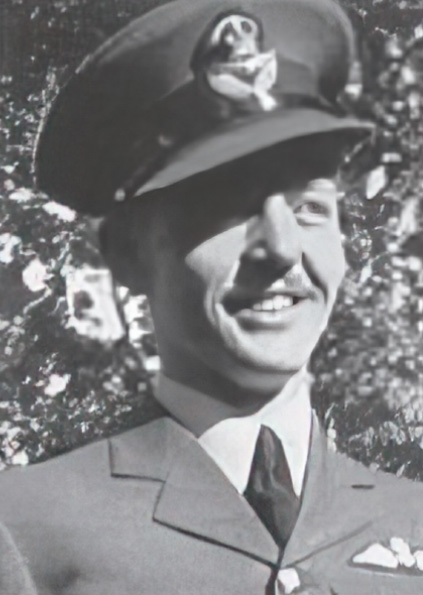
I was from Calgary in Canada, where I lived with my parents Joseph and Mary Greenan.
In 1937 I had joined the Royal bank of Canada as a junior clerk and by the time I left in 1940, I had worked my way up to ledger clerk.
I enjoyed sport, and played Hockey, Baseball, Curling, tennis and Golf.
Joining the Royal Canadian Air Force in 1940, I subsequently qualified as a pilot on 20th September 1941. Following all the subsequent training, I arrived at my first operational unit, 57 Squadron at Scampton, at the beginning of 1943.
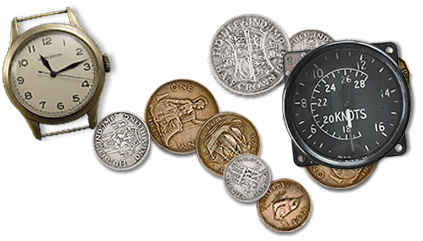
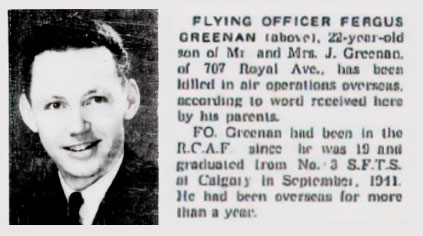
The Calgary Herald.
MY AIRCRAFT
The Avro Lancaster was a development of the ill-fated Avro Manchester. The twin engine Manchester had been an unmitigated disaster, under-powered and crash prone. Undeterred, the designer Roy Chadwick increased the wingspan and added two more engines. From a disastrous start, the most legendary bomber of all time was born.
From 1942 onwards the Lancaster, together with the Handley Page Halifax, provided the backbone of bomber command. Equipped with four Rolls Royce Merlin engines, the same engine which powered the equally legendary Spitfire, the Lancaster could deliver 18,000 lbs of bombs to targets up to 2500miles away. Later versions of the Lancaster carried even bigger specialist bombs designed by Barnes Wallis of Dambusters fame.
During the Second World War, The Lancaster conducted a total of 156,000 sorties and dropped 608,612 tons (618,378,000 kg) of bombs. A total of 7377 Lancasters were built, of which 3736 were lost to enemy action and accidents.
Today, only 17 complete Lancasters survive, with just two flying examples. The Battle of Britain Memorial Flight’s PA474 and the Canadian Warplane Heritage’s FM213.
Crew: 7
Span: 102 ft
Length: 69 ft 6 in (tail up)
Height: 20 ft 6 in (tail up)
Empty weight: 37,000 lbs
Loaded weight: 65,000 lbs
Engine: 4 x Rolls-Royce Merlin 24 V-12 engines
Engine power: 1,620 hp at 3,000 rpm (1,208 kW)
Maximum speed: 275 mph
Range: 2,530 miles with 7,000 lbs of bombs
Ceiling: 22,000 ft
8 x .303-caliber machine guns
18,000 lbs of bombs
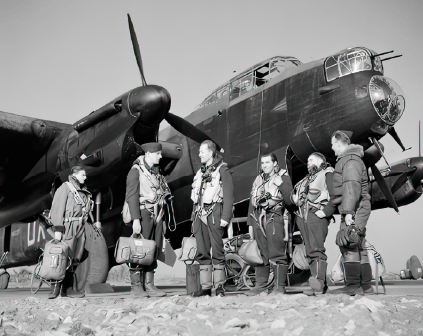
The Greenan crew in front of their Lancaster at Scampton.
MY ROLE
I was the pilot and Captain of this aircraft. All the training to learn to fly this aircraft and how to use it fight the enemy took nearly 3 years. I was killed less than 3 months after arriving on my first operational squadron.
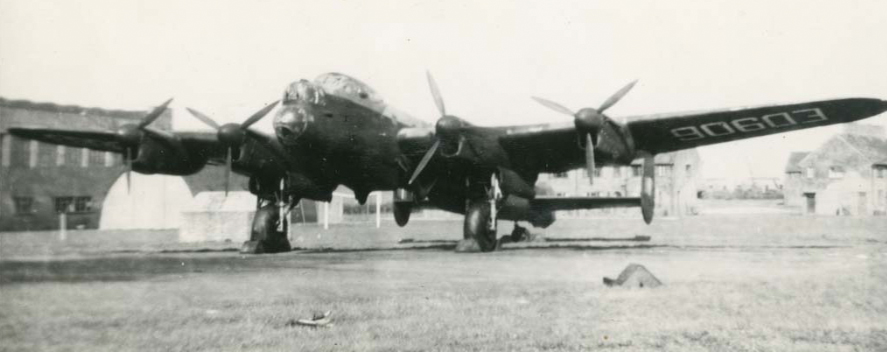
MY SQUADRON
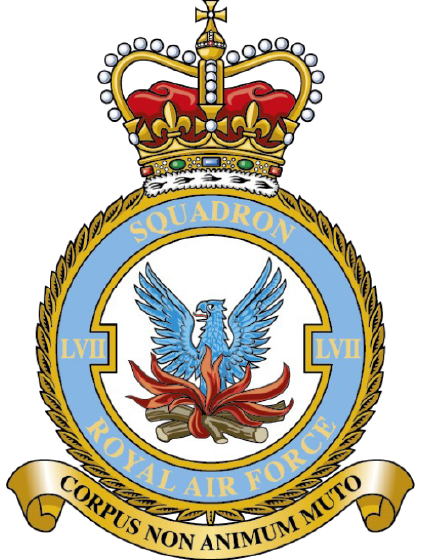
Motto: Corpus non animum muto
‘I change my body not my spirit’
57 Squadron was formed on 8th June 1916 as part of the Royal Flying Corps, initially as a training unit. By October of the same year, they received their first operational type, the Royal Aircraft Factory FE2d, with which they would fly fighter reconnaissance missions in France.
The pace of aviation technological development was rapid and by the middle of 1917, the FE2d was obsolete and the squadron suffered severe losses, on one occasion losing 5 aircraft in a single mission. The situation was only reversed when the squadron received the more advanced Airco DH 4 and switched to a bombing role. Following the end of hostilities, the squadron was disbanded on 31st December 1919.
57 Squadron reformed on 20th October 1931, flying the Hawker Hart in the light bomber role. As the world moved closer to war, they converted to the Bristol Blenheim, a type though by the RAF to be on the cutting edge of light bombers. In reality, it was already obsolete at the outbreak of war and by November 1940, they were flying the Vickers Wellington from RAF Feltwell. In September 1942, they moved to Scampton and converted to the Avro Lancaster, with which they were to fight the remainder of the war.
In the post war years, they first flew the Avro Lincoln, before entering the jet age with the English Electric Canberra. They next moved on to the nuclear armed Handley Page Victor, holding Britain’s nuclear deterrent. When this was passed to the Royal navy, the Victors were used in the air-to-air refuelling role, famously providing fuel to the Vulcans that undertook the Blackbuck missions during the Falklands War.
From 1992-2002, the squadron performed the strategic transport mission with it Lockheed C130 Hercules and in 2008, it switched roles back to its roots as a training squadron, flying the Grob Tutor and Prefect, a role which it performs to this day.
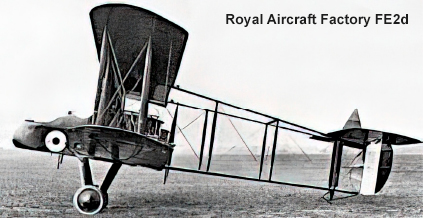
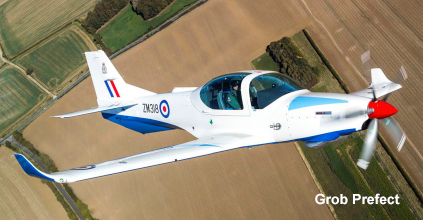
THE ACCIDENT
We had quite a few missions under our belt by now and we were starting to feel that we were an experienced crew. In fact, one of the crew had written home, saying he was beginning to think he might make it through after all. However, this was a big mission, we were flying to the very heart of Nazi Germany. Tonight the target was Berlin, the most heavily defended city in the whole of Europe.
The details of what the target was to be was kept very secret, right up until the curtain was drawn back in the briefing room to reveal a map of Europe with a long piece of ribbon leading from Scampton to the target. Despite this, crews had a clever way of working out were the target might be. If during the day, the aircraft’s tanks were filled to the brim with fuel and the armourers loaded a relatively light bomb load, you knew you were going a long way. More often than not, going a long way meant Berlin.
The mission went well, the weather over Berlin was good, the pathfinders laid accurate marking flares and bombing results were assessed as good. As the bombers left the target area, they could still see Berlin burning from 200 miles away.
At around 2am we arrived back over Lincolnshire and descended through cloud towards Scampton and safety. But, as we broke cloud, another Lancaster appeared and the collision claimed the lives of all onboard our aircraft and 3 of the seven on the other.
The other Lancaster involved was ED490 of IX Squadron, based at RAF Waddington. The pilot of this aircraft survived and gave the following account:
“We were in the circuit; I could see the flare path and was talking to the control tower. It was my turn to land and as I looked up there was another Lancaster breaking cloud and heading straight towards me. At that height I had no wish to put the nose down so I tried to climb over the other aircraft but did not manage it. The next thing I knew he hit me almost head-on. I don’t think he saw me and still often wonder what he was doing there. He was from Scampton and using his Gee lattice lines should have been nowhere near us. We came down at Heighington, three miles ESE of Lincoln and he flew on hitting a high tension pylon at Riseholme near Scampton. I remember when the aircraft hit us saying to myself Well that’s your bloody lot; you won’t get out of this”.
The funeral for four of our crew took place at Scampton, where we were buried with full military honours.
CASUALTIES – 2ND MARCH 1943
Flying Officer John Greenan (Pilot) RCAF (Buried Scampton)
Flight Sergeant Frederick Warren Music (Navigator) RCAF (Buried Scampton) MORE
Sergeant Harold Ricketts (Wop/AG) RCAF (Buried Scampton) MORE
Sergeant John Mallett (Flight Engineer) RCAF (Buried Scampton) MORE
Sergeant Frank Miller (Air Gunner) RCAF (Buried Scampton) MORE
Sergeant Herbert Turkentine (Bomb Aimer) RAF (Grove Park Cemetery)
Sergeant Ronald Roberts (Air Gunner) RAF (Alperton Cemetery)
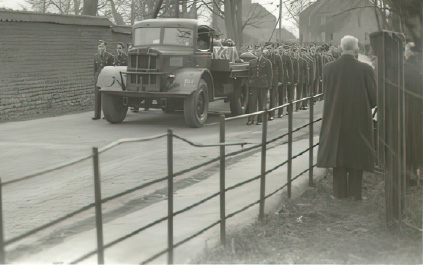
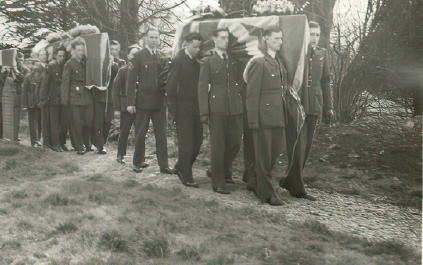

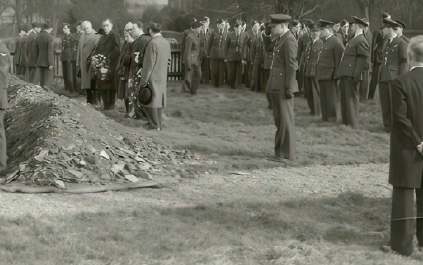

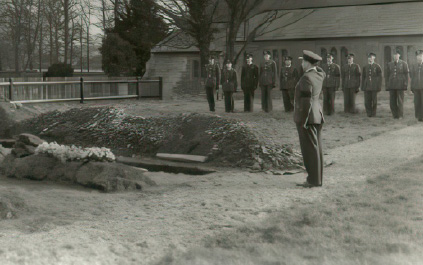
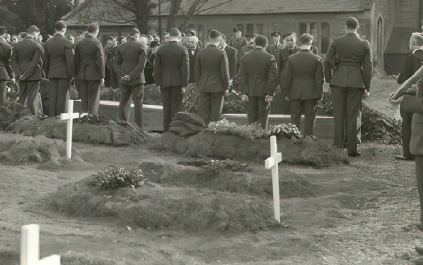
Where Next
Visit Lancaster PA474 at the Battle of Britain Memorial Flight RAF Coningsby.
BBMF Visitor Centre, Dogdyke Road, Coningsby, LN4 4SY Telephone: 01522 782040
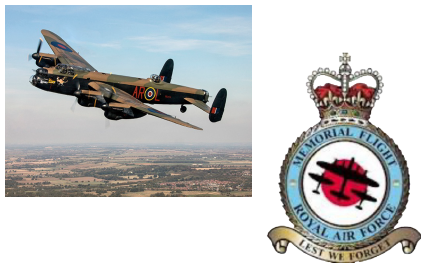
ON THIS DAY IN WORLD WAR TWO – 2ND MARCH 1943
In Rome, Mussolini withdraws his troops from the eastern front.
Berlin suffers the biggest air raid of the war so far.
